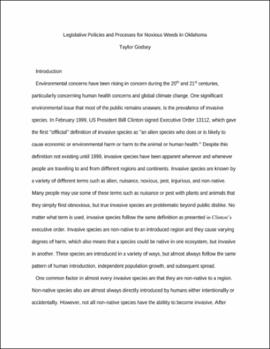| dc.description.abstract | Invasive species have two primary factors in common with one another; these organisms are non-native and their spread was caused by human interference. Invasive species have existed as long as humans have been able to traverse worldwide because human transport methods have given invasive species the ability to overcome their biogeographical boundaries. Recent decades have seen legislative measures created to combat especially problematic invasive species. One such legislative action was the Federal Noxious Weed Act of 1974, which was passed to establish a system to control especially problematic invasive plants in the United States. This federal law requires every state to have their own State Noxious Weed List of invasive plants in addition to the Federal Noxious Weed List. Any plant species recorded on the Noxious Weed Lists cannot be bought, sold, traded, transported, or possessed and control treatments are required. While every state has a State Noxious Weed List, no two lists are identical and the lists vary greatly in the number of species considered to be noxious weeds. States like Colorado have developed extensive State Noxious Weed Lists, yet Oklahoma has one of the shortest lists in the nation. In Oklahoma, the original three noxious weeds that started our state’s list remain the only species required for control under the Noxious Weed Act. There are several invasive plants in Oklahoma that are listed as noxious weeds in other states, however the only venue of control for many invasive plants is through the weed-free hay programs. This study’s primary goal was to assess the effectiveness of Oklahoma’s Noxious Weed Act in comparison to Colorado and Kansas Noxious Weed Acts. This also included evaluating invasive plants that were of concern in Oklahoma and in Oklahoma’s bordering states. After considering the policy, the presence of invasive plants, and the issues with Oklahoma’s current system, four recommendations were made: amending Oklahoma’s current policy, forging a new invasive plant policy focusing on invasion prevention, creating county-level noxious weed lists for Oklahoma, or combining all three proposals into one extensive Noxious Weed Act. | |
